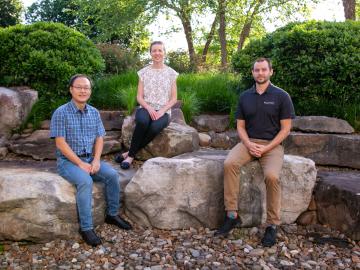Filter News
Area of Research
- (-) Biology and Environment (50)
- (-) Fossil Energy (1)
- Advanced Manufacturing (17)
- Biological Systems (4)
- Building Technologies (8)
- Chemical and Engineering Materials (1)
- Clean Energy (198)
- Climate and Environmental Systems (4)
- Computational Biology (1)
- Computational Engineering (3)
- Computer Science (12)
- Electricity and Smart Grid (2)
- Energy Sciences (4)
- Functional Materials for Energy (2)
- Fusion and Fission (17)
- Fusion Energy (8)
- Isotope Development and Production (1)
- Isotopes (10)
- Materials (143)
- Materials Characterization (2)
- Materials for Computing (14)
- Materials Under Extremes (1)
- Mathematics (1)
- National Security (16)
- Neutron Data Analysis and Visualization (2)
- Neutron Science (47)
- Nuclear Science and Technology (26)
- Nuclear Systems Modeling, Simulation and Validation (2)
- Quantum information Science (4)
- Renewable Energy (2)
- Sensors and Controls (2)
- Supercomputing (61)
- Transportation Systems (4)
News Type
News Topics
- 3-D Printing/Advanced Manufacturing (5)
- Advanced Reactors (1)
- Artificial Intelligence (3)
- Big Data (1)
- Bioenergy (13)
- Biology (21)
- Biomedical (2)
- Biotechnology (2)
- Chemical Sciences (5)
- Clean Water (3)
- Climate Change (12)
- Composites (2)
- Computer Science (4)
- Coronavirus (2)
- Critical Materials (1)
- Cybersecurity (1)
- Decarbonization (2)
- Energy Storage (3)
- Environment (24)
- Fusion (1)
- Grid (2)
- High-Performance Computing (5)
- Hydropower (3)
- Isotopes (2)
- Machine Learning (2)
- Materials (8)
- Materials Science (3)
- Mercury (1)
- Microscopy (2)
- Molten Salt (1)
- Nanotechnology (5)
- Neutron Science (2)
- Nuclear Energy (1)
- Partnerships (1)
- Physics (1)
- Polymers (1)
- Simulation (2)
- Sustainable Energy (10)
- Transformational Challenge Reactor (1)
- Transportation (3)
Media Contacts
A team from Oak Ridge National Laboratory, Duke University and other institutions studying Sphagnum moss have identified two new species in North America, and they are learning how evolution may affect the species’ role in carbon storage.

Global carbon emissions from inland waters such as lakes, rivers, streams and ponds are being undercounted by about 13% and will likely continue to rise given climate events and land use changes, ORNL scientists found.

A team of scientists led by Oak Ridge National Laboratory developed a theory that thylakoids, membrane networks key to plant photosynthesis, also function as a defense mechanism to harsh growing conditions, which could aid the development of hardier plants.
Scientists at Oak Ridge National Laboratory are closer to unlocking the secrets to better soil carbon sequestration by studying the tiny, sand-like silicon deposits called phytoliths in plants.

The Department of Energy’s Office of Science has selected three Oak Ridge National Laboratory scientists for Early Career Research Program awards.

Stan Wullschleger, associate laboratory director for biological and environmental systems science at ORNL, is the recipient of the 2022 Commitment to Human Diversity in Ecology Award from the Ecological Society of America, or ESA.

ORNL, TVA and TNECD were recognized by the Federal Laboratory Consortium for their impactful partnership that resulted in a record $2.3 billion investment by Ultium Cells, a General Motors and LG Energy Solution joint venture, to build a battery cell manufacturing plant in Spring Hill, Tennessee.

Researchers at Oak Ridge National Laboratory are using a novel approach in determining environmental impacts to aquatic species near hydropower facilities, potentially leading to smarter facility designs that can support electrical grid reliability.

A new analysis from Oak Ridge National Laboratory shows that intensified aridity, or drier atmospheric conditions, is caused by human-driven increases in greenhouse gas emissions. The findings point to an opportunity to address and potentially reverse the trend by reducing emissions.

Scientists have developed a novel approach to computationally infer previously undetected behaviors within complex biological environments by analyzing live, time-lapsed images that show the positioning of embryonic cells in C. elegans, or roundworms. Their published methods could be used to reveal hidden biological activity.




